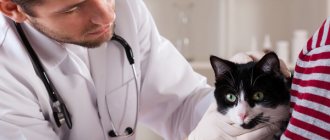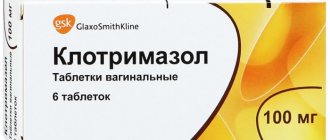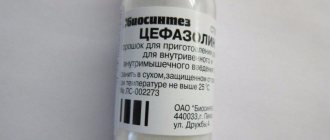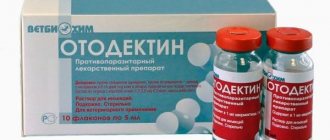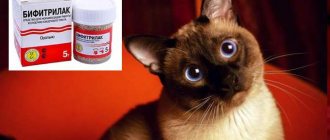Special precautions:
Unidox should not be used in cats with allergies.
to it or other tetracycline antibiotics. Use with caution in cats with impaired liver or kidney function. Do not use in pregnant or nursing cats or kittens as this medication may cause slow bone growth and discoloration of teeth. Other medications, such as antacids, vitamin and mineral combinations, iron, or Pepto-Bismol, should be used at least 1 hour before or 4 hours after taking Unidox. Use caution when coadministering digoxin or warfarin. Giving Unidox to cats does not depend on the time of feeding.
Antibacterial agents
Doxycycline as an antibacterial drug belongs to the tetracycline group. Doxycycline is used to treat a number of different infectious and inflammatory diseases, from when a cat is seriously ill with hemobartenellosis, in which the hematopoietic process of the animal’s body is disrupted, to wounds and scratches that a cat can receive due to a fight with another animal, or as a result of injury. But you need to pay attention that you can give cats Doxycycline only after passing all the tests and according to the scheme developed by the veterinarian.
In domestic veterinary practice, when treating infectious and inflammatory diseases in cats and dogs, doctors have to prescribe the drug Doxycycline, which is prescribed to people. The fact is that this is practically the only analogue of a drug for cats that can be purchased in our country - the drug Ronaxan, produced in France. It comes in tablet form.
With a very severe viral infection, it is impossible to do without Amoxicillin for cats. This is a long-acting semi-synthetic antibacterial drug. But due to the fact that it is produced in Spain, it is often not available in our market. As a substitute, the veterinarian may prescribe Flemoxin Solutab. The 1st tablet contains acid-resistant amoxicillin . The drug has a strong bactericidal effect.
How should I take Unidox?
Exactly as prescribed by your veterinarian. Follow all directions on the assignment sheet. Do not take more or less of this medication or for longer than recommended.
Give your cat Unidox dissolved in water. Pour water into your pet's mouth so that the tablet does not linger in the lumen of the esophagus and cause irritation. Provide your cat with plenty of fluids while being treated with this medication.
The drug can be taken with food or milk if the medicine upsets the stomach and causes vomiting. Unidox should be used in cats according to the instructions for use.
Use Unidox Solutab for cats for the entire prescribed period of time.
Your pet's symptoms may disappear much earlier than full recovery occurs. Stopping the drug early or skipping doses may also increase the risk of recurrent infection and the development of antibiotic resistance in bacteria. Unidox will not treat viral infections in cats such as herpesvirus, panleukopenia, or calicivirus. However, antibiotics eliminate the secondary microflora that complicates the course of the disease in domestic cats.
If your cat needs surgery, tell the surgeon in advance that you are using Unidox.
Store at room temperature away from moisture, heat and light.
Throw away any unused medicines after the expiration date stated on the label. Using expired Unidox can cause kidney damage.
What analogues are there?
Ronaxan
The drug is available in tablets, the dose of the active substance is 10 mg/kg. Sick animals need to be given daily, and it is important not to forget to maintain the dosage. We recommend dividing the dosage, in which case a constant level of the active substance in the blood will be maintained.
Analogue
Vibramycin
This drug is available both in the form of capsules and as a solution for intravenous administration. A huge advantage is that these are tetracycline antibiotics. This suggests that they can actively fight gram-positive and gram-negative pathogens.
First, the cat should be given the maximum possible dose, that is, 4 mg/kg, and then the dose is gradually reduced. We recommend using injections only in a veterinary hospital. Since self-treatment with injections can only harm your pet.
What should I avoid when giving Unidox to cats?
Do not give cats iron supplements, multivitamins, calcium supplements, antacids, or laxatives within 2 hours before or after taking Unidox.
Avoid taking any other antibiotics with Unidox unless your veterinarian prescribes it for you.
Do not prescribe the drug yourself.
Avoid exposure to sunlight or tanning beds. Unidox may cause diarrhea, which may be a sign of a new infection. If your cat has watery or bloody diarrhea, call your veterinarian. Do not use antidiarrheal medications on your own.
Instructions
The dosage for a cat is 5-10 mg per 1 kg, the drug is used once. If the maximum possible dose is used, then it should be divided equally, the first part should be applied in the morning and the second in the evening. The drug must be placed in the cat's mouth, and then a little milk from a syringe must be poured into the cat's mouth. In this case, you will be sure that the drug is in the cat’s body. Remember that the pet must be kept together. If you perform this procedure alone, your cat may scratch you.
Do not pour large amounts of milk into the cat's mouth, as this may weaken the effect of the drug.
Unidox - side effects in cats
Seek emergency veterinary help if your cat has any signs of an allergic reaction to Unidox: (hives, difficulty breathing, swelling of the face or neck) or a severe skin reaction (fever, skin pain, redness, or a purple skin rash that spreads and causes blistering and peeling), regurgitation or vomiting, painful swallowing.
Call your veterinarian right away if your cat shows the following signs:
- severe abdominal pain, watery or bloody diarrhea;
- throat irritation, problems swallowing;
- chest pain, irregular heart rhythm, shortness of breath;
- little or no urination;
- low white blood cell count—fever, chills, bleeding;
- dizziness, nausea, vision problems;
- loss of appetite, upper abdominal pain, nausea or vomiting, fast heartbeat, dark urine, jaundice (yellowing of the skin or eyes).
Common side effects of Unidox in cats may include:
- nausea, vomiting, upset stomach, loss of appetite;
- mild diarrhea;
- skin rash or itching;
- darkened skin color.
Always consult your veterinarian.
Interaction with other drugs
When prescribing Doxycycline, the following points must be taken into account:
- absolutely incompatible with penicillins and cephalosporins;
- should not be combined with medications based on magnesium and iron;
- may be poorly tolerated in combination with aluminum and calcium-containing drugs;
- simultaneous administration of methoxyflurane during surgery can cause severe renal failure, including death;
- simultaneous use of anticoagulants requires constant monitoring of blood clotting.
When prescribing Doxycycline, drug interactions must be taken into account
Attention! If your pet is taking vitamin complexes or other medications at the time of taking Doxycycline, the veterinarian must know about them. Even with good compatibility of drugs, a particular individual may experience side effects during complex therapy.
Learn about the main antimicrobials in animals
- Yodez
- Vibramycin
- Iodoform
- Iodinol
- Kanamycin
- Uses of iodine
- Iodopyrone in animals
- Potassium permanganate
- Sinulox in veterinary medicine
- Bactrim
- Ampicillin
- Benzylpenicillin
- Griseofulvin
- Diamond green
- Hexamethylenetetramine
- Tobramycin eye drops
- Natural penicillins
- Nystatin
- Oxacillin
- Neomycin
- Metronidazole
- Furadonin in animals
- Penicillins in veterinary medicine
- Methylene blue
- Tsiprovet tablets
- Levofloxacin for animals
- Tsiprovet drops for veterinary medicine
- Amikacin
- Lincomycin
- Imipenem
- Ketoconazole
- Itraconazole
- How to dilute cefazolin?
- Instructions for veterinary use of phthazine
- Tobramycin in veterinary medicine
- Cephalexin
- Amoxicillin in veterinary medicine
- Gentamicin for animals
- Use of cefazolin in veterinary medicine
- Enrofloxacin in veterinary medicine
^Top
General information
Clindamycin, commonly known under the brand names Antirobe® and Cleocin®
, is an antibiotic that is used to treat cats. Clindamycin inhibits bacteria by inhibiting protein synthesis and growth. Erythromycin and its derivatives have a similar mechanism of action. Clindamycin is similar to the drug lincomycin (lincocin).
Clindamycin is effective against a narrow range of bacteria in dogs and cats. It is effective against bacteria that affect the skin, mouth, bones and respiratory tract. Clindamycin is a prescription drug and can only be obtained from a veterinarian or with a prescription from a veterinarian.
Broad-spectrum antimicrobials in tablets
Every day our body is attacked by thousands and millions of different bacteria, viruses and microorganisms. He has learned to cope with the main part, but some still manage to penetrate the body, causing significant damage to health.
To destroy them, pharmacists have developed antimicrobial, antibacterial and antifungal drugs. Unfortunately, viruses mutate over time, and previous medications become ineffective. Today, you can purchase broad-spectrum antimicrobial drugs at the pharmacy that can destroy several viruses at once. In this article we will look at which of them are most effective, for which diseases their use is indicated and their price category.
Broad-spectrum antimicrobials
Among all medications, I would like to pay special attention to antibiotics. Many patients simply do not like them, claiming negative consequences after their use. But one cannot ignore the fact that it is thanks to them that dangerous epidemics can be stopped and millions of human lives saved.
They have a large radius of action, thanks to which they destroy many bacteria. New generation medications turn out to be the most effective due to the fact that microorganisms have not had time to adapt to the new active substance.
Advantages of new generation antibacterial agents over conventional antibiotics:
- compared to antibiotics marketed more than ten years ago, there is a comparatively smaller list of adverse reactions;
- no need to use three or four times a day, one or two applications are enough;
- different forms of release: tablets, injection solutions, suspensions, ointments, patches.
Antibacterial and microbial agents are divided into three classes:
Some of them have such a pronounced effect that they destroy not only harmful microorganisms but also all beneficial microflora in the intestines. That is why it is recommended to take probiotics with them. They also have a negative effect on the liver and kidneys.
To prevent viruses and bacteria from adapting and mutating, antibiotics are taken in the maximum dosage prescribed by the doctor. The duration of therapy is determined by the severity of the disease and the type of pathogen.
There are a number of medications that are effective against protozoal infections. For example, nitroimidazole derivatives: ornidazole, metronidazole, tinidazole. Metronidazole is in particular demand among them, mainly due to its low pricing policy. But tinidazole, although it is a complete analogue, cannot be administered intravenously or intramuscularly.
Antibacterial agents of a wide range of action are divided into:
- III and IV generation cephalosporins;
- natural penicillins;
- dioxidins;
- inhibitor-protected and antipseudomonas penicillins;
- aminoglycosides;
- fosfomycin;
- rifampicin;
- aminopenicillins inhibitor-protected;
- tetracycline;
- chloramphenicol;
- macrolide;
- sulfonamides;
- nitroimidazole series agents;
- a number of carbapenems;
- means of a number of nitrofurans;
- fluoroquinolones and quinolones.
Narrow range products are not included in this list. They are prescribed to the patient when the type of causative agent of the disease is precisely determined. Not used empirically or in the treatment of superinfections.
In tablets
This section will provide a list of antibacterial medications that have a wide range of new and old generations. They are effective against gram-negative and gram-positive microbes.
- Third and fourth generation cephalosporins: Cefantral, Ceftriaxone, Cefotaxime, Tax-o-bid, Cefpirom, Loraxim.
- Aminopenicillins: Amosin, Amoxicillin, Sulbactam, Ecobol, Amoxisar, Clavulanate.
- Third generation aminoglycosides: Netromycin, Netilmicin, Nettacin.
- Semi-synthetic 16-membered macrolides: Macropen.
- Semi-synthetic 14 and 15 macrolides: Rulicin, Brilide, Roxibid, Azithromycin.
- Carbapenems: Invanz, Ertapenem, Meropenem.
- Fluoroquinolones 3 and 4 generations: Sparflo, Gatifloxacin, Moxifloxacin, Levofloxacin.
- Nitrofurans: Furagin, Nifuroxazide, Nitrofurantoin.
The child's body is extremely susceptible to all kinds of medications, especially antibacterial ones. Therefore, the list of acceptable drugs is significantly reduced.
We recommend reading: How to Care for a Corella Parrot
New generation drugs for children:
- cephalosporins: Cephalexin, Torocef-Cefazolin;
- aminopenicillins: Femoxin, Summed, Amosin, Amoxiclav;
- macrolides: Zithrocin, Midecamycin, Rovamycin.
At the moment there is a huge list of ointments, the main active ingredient of which is an antibiotic. Sold in every pharmacy, available without a prescription. They do not cause as much concern among patients as the use of tablets, suspensions or injections.
When choosing, it is necessary to take into account the stage of the wound process. For minor inflammations and superficial wounds, you can get by with antiseptics and antimicrobial ointments, but for deep tissue damage, you will need an antibacterial one that relieves pain.
Antibiotics are also available in the form of aerosols and powders.
Our readers successfully use Intoxic to get rid of parasites. Seeing how popular this product is, we decided to bring it to your attention. Read more here...
Broad-spectrum antimicrobial ointments:
- Tetracycline (tetracycline) is used to treat eye and skin conditions.
- Levomycetin, Levosin, Levomikol (levomycetin). Due to frequent cases of the development of aplastic anemia after internal use, chloramphenicol is used only for external treatment of wounds.
- Zenerit, Erythromycin (erythromycin). Both medicines act gently and carefully, therefore they are approved for treating wounds, superficial rashes, and eye diseases for children and adults.
- Clindovit, Dalatsin, Klenzit S (clindamycin). The duration of treatment can be about six months. Used for skin diseases and cosmetic problems.
- Gentaxan, Gentamicin (gentamicin). Helps cope with streptoderma. Prohibited for use by children under three years of age, pregnant and lactating women. The ointment is practically not absorbed and does not enter the bloodstream. Only local application is necessary, directly to the affected area.
Using the ointment will bring results, provided that the bacteria are on the surface and have not affected the internal organs. If the infection begins to spread, a combination of tablets and ointments is necessary.
List of broad-spectrum antimicrobials
Broad-spectrum antimicrobial agents are an excellent help for both the doctor and the patient when it is necessary to start treatment urgently, and there is no time to wait for test results. They are effective against many viruses and bacteria.
The most popular drugs are:
- Sumamed;
- Amoxicillin;
- Avelox;
- Cefamandole;
- Cefixime;
- Rulid;
- Cefoperazone;
- Unidox Solutab;
- Lincomycin.
Despite the large list of names, it is impossible to say which of them will be the safest and will not cause adverse reactions. Each of them is intended to treat a specific type of disease.
Some effectively cope with intestinal pathogens, while others work only in the upper and lower respiratory tract. Therefore, self-medicating and taking them for prevention is not only useless, but also dangerous to health. The appointment should only be made by a doctor who will make a diagnosis and study the individual characteristics of the patient’s body.
Antibacterial medications are of artificial and natural origin, they are united by the main task of suppressing the growth of bacteria and fungi. In order for their use to bring positive results and not have a negative impact on health, you must follow some rules:
- At the first signs of illness, you should visit a doctor. He will make a diagnosis, prescribe a medicine, the duration of its use and the optimal dosage.
- It is forbidden to replace the medicine without first consulting with your doctor.
- Treatment should not be prolonged or interrupted.
- Self-medication is dangerous to health; it is not recommended to buy pills on the advice of friends who have similar symptoms of the disease as you.
- It is strictly forbidden to give antibiotics to children without a pediatrician's prescription.
Unfortunately, dangerous viruses, bacteria and fungi gradually mutate. Their sensitivity to the active ingredients changes. Accordingly, their effectiveness decreases, which at some point will cause the lack of results of the treatment. Therefore, pharmacists work every day to create a new generation of medicines.
Conclusion
Over the entire period of production of antimicrobial drugs, more than seven thousand items have been produced. The bulk is not currently produced due to decreased efficiency, strong adverse reactions, and bacteria becoming accustomed to the main components. Today, about 150 drugs are used, 25 of which are the latest antibiotics, which are mainly prescribed to patients. Do not forget that for successful treatment, any drug should be prescribed only by a specialist.
- III and IV generation cephalosporins;
- natural penicillins;
- dioxidins;
- inhibitor-protected and antipseudomonas penicillins;
- aminoglycosides;
- fosfomycin;
- rifampicin;
- aminopenicillins inhibitor-protected;
- tetracycline;
- chloramphenicol;
- macrolide;
- sulfonamides;
- nitroimidazole series agents;
- a number of carbapenems;
- means of a number of nitrofurans;
- fluoroquinolones and quinolones.
When can you give Doxycycline to a cat?
The drug can be given to cats if their condition requires it. The medication is prescribed in strictly defined cases after tests and an in-person examination by a veterinarian:
- infectious lesions of any body system;
- treatment of chlamydia and eye lesions, including conjunctivitis;
- prevention of postoperative complications and their therapy;
- elimination of purulent lesions on the skin;
- infections of the gastrointestinal tract and biliary tract;
- elimination of the inflammatory process during genitourinary infections.
Symptoms of the most common infectious diseases in cats
Doxycycline is not used for viral infections, which cat owners often do out of ignorance. Bacteria and viruses have completely different effects on the body, belong to different groups of pathogens and require different approaches to therapy. Viruses are eliminated by immunomodulators and antiviral agents.
Examination of a cat by a veterinarian
Attention! When self-treating a pet with Doxycycline, it is necessary to exclude absolutely all contraindications and begin therapy with a minimum dose. After the first dose, it is recommended to monitor the cat's condition. If her health worsens, she needs to see a doctor for additional testing and possible symptomatic treatment due to the side effect.
